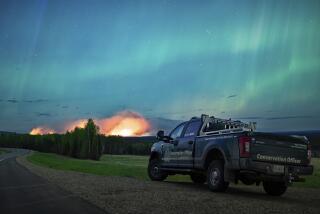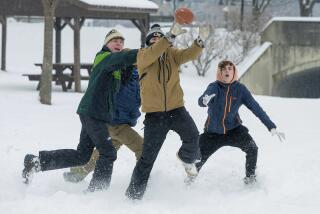Cold Holds Grip on Great Lakes, Moves East; 11 Deaths Reported
- Share via
A Canadian high pressure system chilled the northern Great Lakes with subzero temperatures Saturday and spread eastward to New England, while a low pressure system off the Washington coast brought rain to the northern and central Pacific Coast.
Freezing weather across the country was blamed for at least 11 deaths in the last two days, most of them in traffic accidents on icy roads, authorities said.
Morning temperatures of 10 to 15 degrees below zero chilled northern Wisconsin and Minnesota. Temperatures also dipped below zero in North Dakota, Iowa and Illinois.
Chicagoans woke up to a 3-degree reading, while it was 6 below in Minneapolis.
Winds gusting to more than 30 m.p.h. combined with temperatures in the single digits and teens over New England to produce wind chills of 20 to 30 below zero, the National Weather Service said.
“It’s basically a large Canadian high pressure system that came down over Wisconsin and spread to the Northeast,” said Paul Fike, weather service meteorologist.
In Caribou, Me., near the Canadian border, Christmas shoppers were out in force, undaunted by a wind chill factor of minus 30, said Caribou Police Sgt. Mike Gahagan. “Life is going on,” he said.
But icy winds drove an overflow of homeless off the streets of Chicago into nine specially opened warming centers.
In Boston, all 400 beds at the Pine Street Inn shelter were taken, and another 200 homeless were to sleep on floors, spokeswoman Lyndia Downie said.
Snow was scattered across northeastern Nebraska, while a mixture of freezing drizzle and snow fell over the south-central portion of the state.
A warm front moving across the northern Plains produced a dramatic difference in temperatures in South Dakota. Pierre reported sunny skies and 41 degrees, while only 100 miles away Huron had clouds and a temperature of 15.
A travelers’ advisory warning of freezing rain was issued for the Cascades and north-central and northeastern sections of Oregon.
More to Read
Sign up for Essential California
The most important California stories and recommendations in your inbox every morning.
You may occasionally receive promotional content from the Los Angeles Times.










